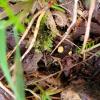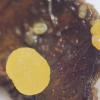
04-01-2026 17:45
 Stephen Martin Mifsud
Stephen Martin Mifsud
I was happy to find these orange asmocyetes which

03-01-2026 13:08
Niek SchrierHi all,We found groups of perithecia on a Lecanora

29-12-2025 17:44
Isabelle CharissouBonjour,J'aimerais savoir si d'autres personnes au

02-01-2026 17:43
MARICEL PATINOHi there, although I couldn't see the fruitbody, I

01-01-2026 18:35
Original loamy soil aside a artificial lake.The co

31-12-2025 19:27
Collected from loamy soil, at waterside (completel
Phaeohelotium monticola on an acorn fragment
B Shelbourne,
10-11-2024 19:47
• Not reddening, croziers, paraphyses and spores suggest P. monticola.
Habitat: On the inside of an acorn pericarp fragment from Quercus robur, at ground level under several cm of leaf litter, damp when found, under the immature tree, on a hill side, sparsely wooded area, 200m alt., Old Lodge nature reserve, Ashdown Forest, High Weald, southern England, early-November.
Apothecia: < ~2 x 2.5 mm, 1 mature and ~4 at various stages of immaturity, initially globose-urceolate and whitish, becoming more yellow and cylindrical-turbinate, eventually turbinate and yellowish, short and slightly obconical stipe, rounded at the base, loosely attached.
Low magnification: Disc and receptacle opaquer, becoming deep yellow, disc initially concave, soon becoming convex, slightly pruinose and uneven appearance, margin slightly irregular and darker, not exceeding the disc, receptacle and stipe with more granulose appearance, some cells protruding at the upper flanks, stipe distinctly granulose and more whitish at the surface, orangish underneath.
Asci: Turgid ~125 x 11.5 µm, croziers, rings bb, Hymenoscyphus-type, possibly some with lower spores inversely oriented.
Spores: Ellipsoid-cylindrical, homopolar with ends rounded or apex more acute, slightly asymmetric or sometimes slightly curved in profile view, usually 1 medium size LB towards each pole and several smaller ones, OCI 2-3, 0-1 (3) septate, some possibly 1-septate in asci, some free spores with brownish walls, one brown spore with a globose protrusion from the side (possibly from both cells).
Free spores in water and some in mature asci (0-1 septate, width of aseptate spores < 5 µm):
15.2-19.6 (20.7) × 4.0- 5.2 (5.5) µm, Q = (3.2) 3.3 - 4.5 (4.7), N = 25, mean = 17.5 × 4.5 µm, Q mean = 3.9.
Paraphyses: Cylindrical, apices mostly uninflated, width ~2-3 µm, occasionally branching from close to the apex, apical 30-50% with highly refractive VBs, possibly initially smaller and globose but most large and cylindrical, chlorinaceous, highly dextrinoid, then brownish after KOH.
Medullary: Text. porrecta-intricata, stipe part more more text. porrecta and larger cells, becoming more text. intricate and smaller cells toward the subhymenium.
Excipulum: At the surface of the stipe and flanks a network of highly irregular hyphae, often protruding, then text. globosa-angularis, becoming more prismatica in transition to medullary.
Marginal hairs: Form seems relatively typical for Hymenoscyphus, with refractive contents like paraphyses, highly dextrinoid.
Exudate: Yellowish, easily disturbed, in the hymenium, at the margin and surface of the flanks, in the subhymenium and edges of the medullary, more orangish around the stipe.
Hans-Otto Baral,
11-11-2024 09:40

Re : Phaeohelotium monticola on an acorn fragment
Yes, typical!
B Shelbourne,
11-11-2024 10:42
Re : Phaeohelotium monticola on an acorn fragment
Thank you. After our discussions on H. geogenus, I wanted to see this species for myself. I had an idea that the higher altitude of this foray might help (monticola) and I noticed the association with Quercus, but I could hardly believe it when I uncovered these apothecia in the first spot I checked under the tree.






 Hymenium-0028.jpeg
Hymenium-0028.jpeg